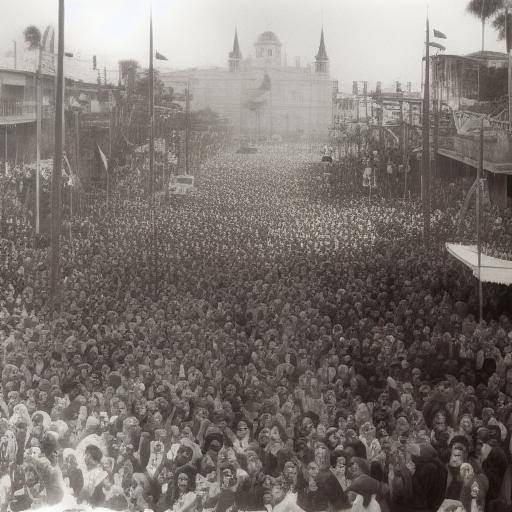
Introduction
In Mardi Gras, or Tuesday of Carnival, the city of New Orleans is filled with color, music and dance. It is the last rampage before Lent, a celebration full of unique traditions that attracts visitors from all over the world. In this article, we will explore the history, the magic of the "krewes" and the significance of the "collars" in this emblematic holiday. Discover how these traditions evolved, their impact on culture and society, and why Mardi Gras is an experience you can't miss.
History and Background
Origin and Evolution of Mardi Gras
The celebration of Mardi Gras has its roots in the ancient pagan holidays that marked the end of the winter and the arrival of the spring. When the French colonizers arrived in New Orleans, they brought with them the Carnival tradition, which evolved into the vibrant festival we know today. Over the years, Mardi Gras has become an emblematic event that encapsulates the very essence of New Orleans.
The Krewes: Pillars of Celebration
The krewes, societies or groups that organize parades and bastions of Mardi Gras, are the true architects of this festival. Each krewe has its own history, banners, and unique displays that add layers of meaning and color to the celebration. From the elegant chariots of the Krewe of Rex to the exuberant and mystical Krewe of Muses, each brings its distinctive style to the epic celebration.
Necklaces: Mardi Gras Treasures
One of the most distinctive aspects of Mardi Gras are the necklaces thrown from the floats and balconies during the parades. These necklaces, adorned with bright colored beads, represent a symbol of joy and camaraderie. For the attendees, catching and collecting these necklaces becomes an exciting game that adds an atmosphere of joy and fun to the celebration.
Detailed Analysis
Mardi Gras Magic: Benefits and Challenges
The economic impact of Mardi Gras in New Orleans is significant, as it attracts millions of visitors every year, generating revenues for local hotels, restaurants and businesses. However, the celebration also poses challenges in terms of security and logistics, which requires careful planning by the authorities.
The Power of Traditions: Real Statistics and Examples
The traditions of Mardi Gras have a tangible impact on the community. From the creation of temporary jobs to the boost in the tourism industry, the holidays have a positive effect on the local economy. However, as the city evolves, debates also arise on how to preserve the authenticity of celebrations in the midst of modernization.
Comprehensive review
Mardi Gras Relevance in News
Mardi Gras is not only an annual event, but has also transcended the borders of New Orleans, influencing popular culture and serving as inspiration for similar celebrations around the world. This lasting legacy is a testimony to the importance and lasting value of the Mardi Gras traditions.
Conclusion " FAQs
Conclusion
In conclusion, Mardi Gras represents the exuberance, history and diversity of New Orleans. From the greatness of its krewes to the thrill of catching necklaces, this holiday transcends mere entertainment to become a living symbol of the collective identity of this fascinating city.
FAQs
- What is the meaning of the necklaces in Mardi Gras? A: The necklaces launched during the Mardi Gras parades symbolize joy andcelebration, and catching them is considered an exciting game that is part of the festive experience.
- What is the role of the krewes in Mardi Gras? A: The krewes are organized groups that plan and execute parades, parties and events during Mardi Gras. Each krewe has its own history, symbols and traditions, bringing unique diversity and wealth to the celebration.
- What's the story of Mardi Gras in New Orleans? A: Mardi Gras has its roots in pre-Christian celebrations and was introduced in New Orleans by the French colonizers in the 18th century. Over the years, it has evolved into the vibrant and colorful holiday we know today.
- What is the economic impact of Mardi Gras in New Orleans? A: Mardi Gras attracts millions of visitors, generating significant income for the city through tourism, hotels, gastronomy and local commerce.
- How are the Mardi Gras parades planned and organized? A: Planning for Mardi Gras parades is a complex task that requires coordination between local authorities, krewes and other agencies to ensure the safety, logistics and fun of attendees.
- How has Mardi Gras evolved over time? A: Mardi Gras has experienced significant changes throughout his history, adapting to the economic, social and cultural circumstances of the city. Despite these evolutions, Mardi Gras' festive essence remains a central element of New Orleans' identity.
With its rich history, vibrant culture and strong celebration, Mardi Gras is truly a unique experience in life. From the majestic krewes to the dazzling necklaces, this holiday continues to distill the vibrant and diverse essence of New Orleans, making it a must-see event for all those who seek to immerse themselves in joy and tradition.
